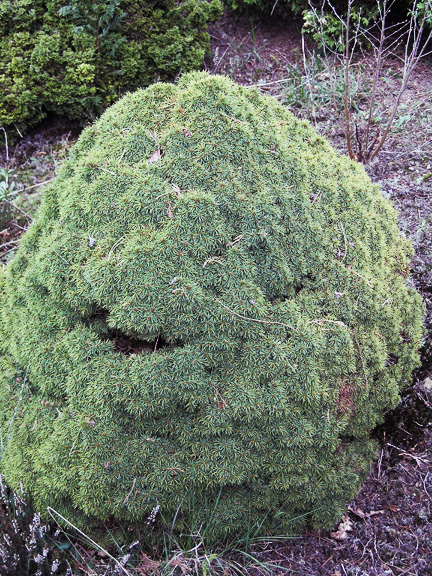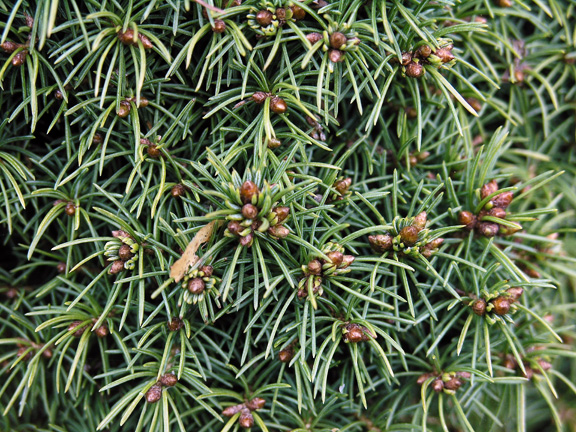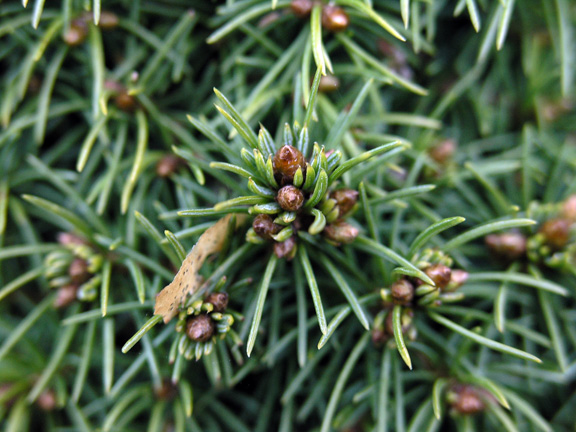
Woody > Picea > Picea glauca > Picea glauca 'Alberta Globe'
Picea glauca
'Alberta Globe'
Alberta Globe White Spruce
Origin: Introduced by C. Streng; Boskoop, Holland it was discovered as a witches broom on Dwarf Alberta Spruce.
Mike's
Opinion


"
Alberta Globe White Spruce is an excellent addition to any garden, especially those with limited space. The interesting shape and foliage adds texture and form to the landscape and due to its low growing habit no facing plants are required allowing it to stand alone in the landscape as a specimen. There is a special spot in any garden for this unique shrub to grow, or use it in a container to add a unique option to your year round container gardening.
Michael Pascoe, NDP., ODH., CLT., MSc. (Plant Conservation)
"
| Family |
| Pinaceae |
| Genus |
| Picea |
| Species |
| glauca |
| Cultivar |
| 'Alberta Globe' |
| Category |
| Woody |
| Type |
| Shrub (evergreen) |
| Pronunciation |
| USDA Hardiness Zone |
| 4–8 |
| Canadian Hardiness Zone |
| 5–9 |
| Temperature (°C) |
| - 29 |
| Temperature (°F) |
| - 20 |
| Height |
| 50–100 cm |
| Spread |
| 50–100 cm |
Photographs
Description and Growing Information
Flowering Period
| General Description |
| Slow growing dwarf, ball shaped evergreen shrub that requires little maintenance. Soft but rigid needles emerge light green, darkening with maturity. Brown buds, less than 1 cm, long form at the ends of branches, with bark appearing light grey-brown, thickening and forming scales as it ages. |
| Landscape |
| This slow growing dwarf conifer is well suited for small garden spaces and rock gardens. It's small globose shape also makes this shrub a nice addition to flower beds and border planting. It can be used as a patio or container plant because it requires very little maintenance. With the foliage growing close to the ground this shrub does not require any facing plants. |
| Cultivation |
| Plant in full or partial shade in soil that is moist but well drained. Alkaline soil will yield the best growth but some acidity will be tolerated; slightly tolerant of urban pollution. Trim lightly to maintain shape and dense growth. |
| Shape |
| A globular shaped dwarf shrub with dense, broadly spreading branches that grow to the ground. |
| Growth |
| Slow |
| ID Characteristic |
| Small, globose, dense shrub with compact branching; the foliage grows close to the ground; therefore, it does not require any facing plants. New growth emerges with a light green colour and becomes dark green with age. Needles are square and 5–8 cm long; brown buds form toward the ends of branches. |
| Pests |
| May be susceptible to aphids and conifer spider mites as well as adelgids gall. |
| Habitat |
| Horticultural origin. |
| Bark/Stem Description |
| Bark emerges as grey-brown when young; as the shrub ages bark becomes thick and forms large scales. |
| Flower/Leaf Bud Description |
| Buds are brown and rigid; they are less than 1 cm. |
| Leaf Description |
| New growth is light, lime green, and darkens to a rich deep green as it ages. Needles are square, 5–8 cm long, growing in a whorled pattern from the stems. The needles are soft but rigid to the touch. |
| Flower Description |
| Not ornamentally significant. |
| Fruit Description |
| Fruit is born in small cones that are less than 1 cm long. They appear near the end of shoots in groups of three with a narrow shape and leathery texture. |
| Colour Description |
| Buds and cones are brown. New growth is light, lime green which darkens to a rich green as it matures. Bark is grey-brown. |
| Texture Description |
| Soft rigid needles are accompanied by rigid brown buds and scaly bark. Cones are small (less than 1 cm) and leathery. |
| Notable Specimens |
| University of Guelph Arboretum, Guelph, Ontario, Canada; St. Mary's Nursery, Winnipeg, Manitoba, Canada. |
| Propagation |
| As a cultivar it can only be propagated by grafting semi-hardwood cuttings. Take cuttings in the winter by removing side shoots and pinching off bottom needles, graft under stock and keep the newly grafted plant moist and warm (18–20°C) by placing in a plastic filmed tent. After five or six weeks, the graft should form calluses, and can be removed from the warmed environment three months later. |
References
Adrian Bloom. Gardening With Conifers. Willowdale: Firefly Books, 2002. Print.


